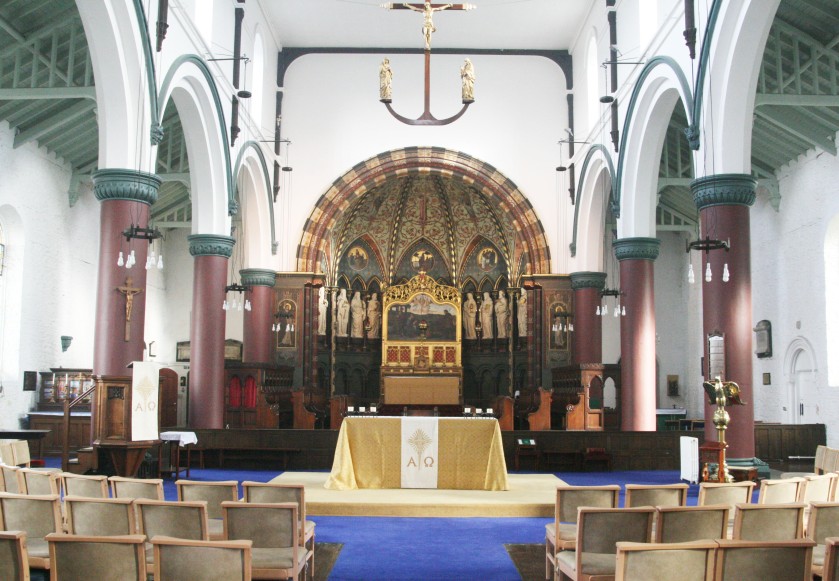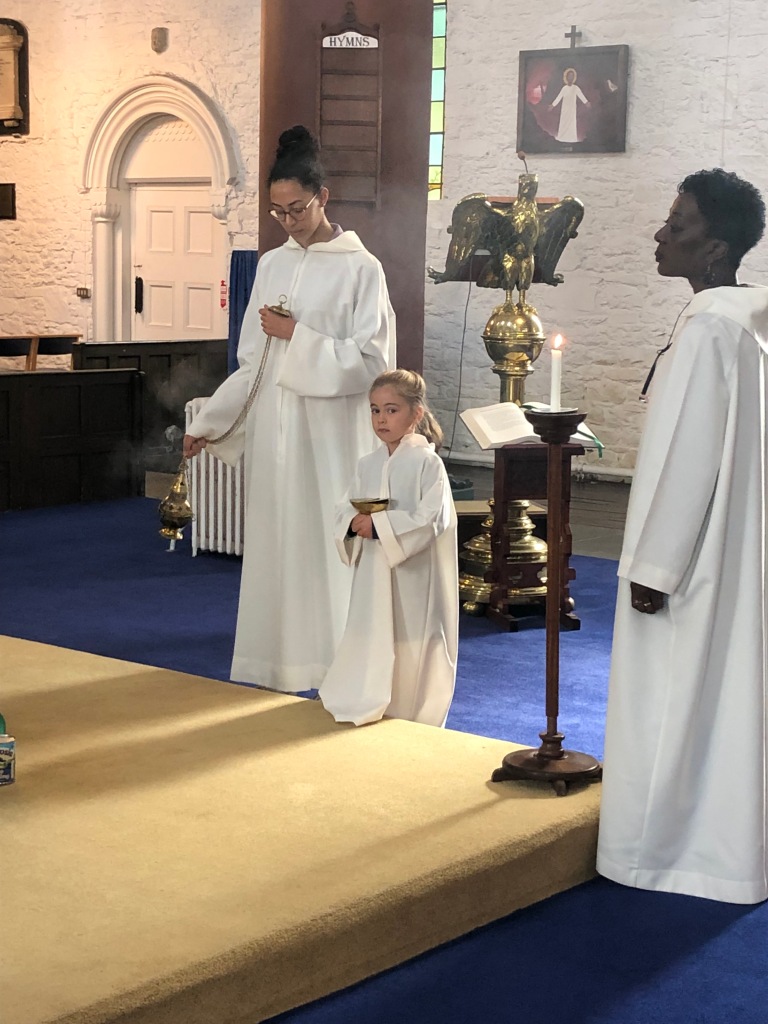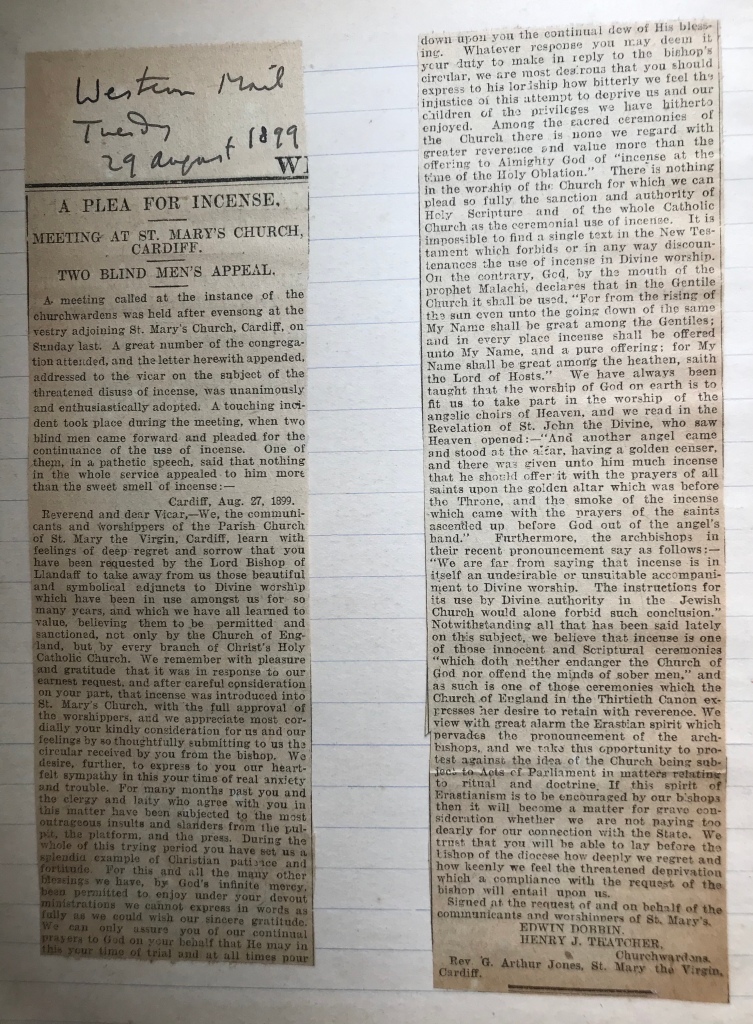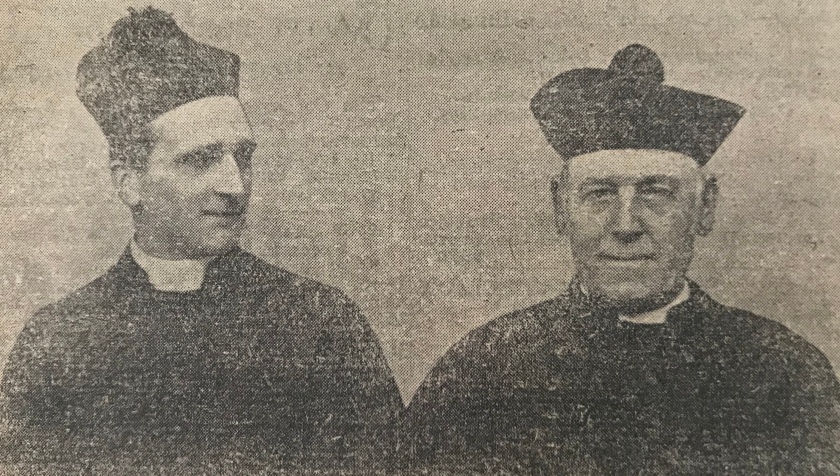The next article of faith is another letter from our archives and written to the successor of Fr Jones who retired as Vicar in 1903. The letter was sent just a year later from the rather ominously sounding “Royal Commission of Ecclesiastical Discipline” to the Reverend Gilbert Heaton.
The Mystery Worshipper
Pinned to the corner of the letter is a newspaper clipping elaborately describing a recent service at St Mary’s. The headlines in the full length article read: “The Sign of the Cross at St Mary’s – Wonderful Music – but what Church?’ The article is credited anonymously to ‘An Onlooker’ and ending with “I have only one question to ask: Is it Church of England or____?” It seems that, back in 1904, St Mary’s had a “Mystery Worshipper.”
The Commission is quick to distance themselves from the particular expressions used by the author and they have been prudent to remove the rather racist introduction to the original article but, nevertheless, they have asked the Rev G. Heaton to present his case!

From the pulpits of Oxford
Fr Heaton was not the first to receive such an enquiry into happenings in his church. The Oxford Movement, which began in 1833 in the pulpits of Oxford Colleges, had produced many followers but also many opponents and those suspicious of anything that hinted of Roman Catholicism or excessive ritual.
Beginning with John Keble’s climb into the pulpit at St Mary’s Church, Oxford to deliver his Assize Sermon, the Movement published many Tracts – giving its followers the name ‘Tractarians’. At first, the initiators had little interest in ritual or externals but it was natural that teaching and doctrine should soon find expression in externals such as ritual and architecture.
Whilst at Jesus College Oxford, Griffith Arthur Jones, the predecessor of Fr Heaton, had been deeply influenced by the Oxford Movement, and made his first confession to Pusey who also gave his name to followers of the movement.
In 1857, he put his hand to the plough when he took up his first living as Vicar of Llanegryn which “was in a very depressed condition,” according to his friend Titus Lewis, the Vicar of Towyn. In his 15 year-long Incumbency there, he revived the worship, introduced a surpliced choir and Gregorian music, and used altar lights and eucharistic vestments, the first to do so in North Wales. The congregation increased both in number and in love of him.
‘From which to preach the catholic faith’
When Fr Jones first climbed into the pulpit at St Mary’s during the Lent of 1872, his text was ‘God is love’ and he always remembered this when dealing with others. Ironically, it was this pulpit which was to create such vociferous objections.
Faced by a large three decker pulpit in the centre of the nave which hid a small altar behinf, the church was “akin to a preaching house” and not suitable for catholic worship. He experienced a few failed attempts to reduce the pulpit in size and move it to the side, and after one of these occasions he encountered on Bute Street one who opposed him who revelled in the defeat. In a characteristically cheerful manner, Fr Jones chirped, “Never mind, the pulpit will serve very well from which to preach the Catholic faith.”

Change here for Rome?
Although Fr Jones introduced a Daily Mass from the earliest time, he was in no hurry to introduce an advanced Ritual. For some years the black gown continued to be used in the pulpit, and surplice and black stole were worn at the Altar. Candles were lit at the Eucharist but were removed immediately after.
Meanwhile, he allowed the Sunday evening Prayer Meetings to continue where participants prayed for the conversion of the Vicar and clergy to the “pure Gospel,” and the Annual Vestry Meetings were, for some years, a tiresome, tedious affair with much opposition.
At one of these meetings someone proposed that a notice-board be put up in the churchyard with the following words: “St Mary’s Junction. Change here for Rome.” Calmly, Fr Jones put the motion to the meeting. It was met with defeat, the proposer deflated.

‘You will lose all your congregation’
When the English Church Union met in the parish with a celebration of Mass vestments had not yet been introduced and so a white chasuble was borrowed from Margam Abbey. Bishop Ollivant wrote to him and referred to “a surplice with a large cross on it.” In his reply, Fr Jones stated that he certainly “had not used any surplice with a cross on it, but only a very handsome chasuble lent by the Vicar of Margam.”
“What better are you of persisting in your work?” asked one parishioner at an early stage of his struggles, “you will lose all your congregation.” “That may be the case,” he gently replied Fr Jones, “but I will get the children.”
“And he got them,” wrote the Western Mail two decades later in 1900. “The congregation of St Mary’s today is composed of the children and grandchildren of those who reviled and buffeted Father Jones a quarter of a century ago.”
In spite of the loud and bawdy opposition, Fr Jones had his supporters who rallied around him and Church attendance grew. The congregation raised £115 for the pulpit to be lowered and moved to the side which paved the way for reordering the church. By 1884, the whole sanctuary had been redesigned.

An Act against ritual acts
All this is far more impressive when considered against the wider backdrop of what was happening across the country. The entrenched objection to what was perceived as the growing ritualism of the Oxford Movement led, in 1874, to the Public Worship Regulation Act which restricted ritual.
Within the next seven years, priests would be prosecuted and imprisoned. Prosecutions ceased only in 1906, two years after Fr Heaton received his letter, and the year that Fr Jones died.
‘To rouse a bitter feeling’
In 1889, the Church Congress had been held in Cardiff, with Services held at its opening at St John’s, St Andrew’s, and St Mary’s. The Congress drew people from across the Church of England, some of whom were opposers to ritual worship and others who had never experienced it before but took great offence.
Afterwards, writing to his parish, Fr Jones said, “Since our last Patronal Festival the celebrated Cardiff Church Congress has been held. Attempts were made to rouse a bitter feeling against St Mary’s Services and work, but these attempts were more than frustrated by the kindness and good feeling of the people of St Mary’s and sympathizers when at a large meeting at the Town Hall you presented your Vicar with a Memorial Address.” Almost eight hundred people had signed it.
‘We must have incense!’
Early in his time at St Mary’s, at the Diocesan Conference, Fr Jones had spoken most clearly. Again and again, amid many cries of “No, no,” he asserted “Yes, we must have incense; yes, yes.” However, whilst very much opposed at these Conferences, he was always greeted with affection which he warmly reciprocated.
On July 31, 1899, the Archbishop’s “Opinion” was delivered announcing the illegality of the liturgical use of incense and portable lights. On the following Sunday, the Feast of the Transfiguration, High Mass at St Mary’s continued with incense and lights. The press reported that the Vicar was defying the authority of the Archbishops even though, at this stage, the “Opinion” held no weight until his own Bishop spoke on the matter.
The Bishop lost no time. A letter was sent to Incumbents on Friday 11 August and appeared in the morning papers the following day. Fr Jones felt it too sudden to make any changes for the following Sunday, and wrote to the Bishop saying that he must beg leave to think and talk over the matter before making sudden alteration.

A Plea for Incense
Several weeks later, a meeting was convened by the Churchwardens at St Mary’s although none of the clergy was present. The meeting wrote a letter to Fr Jones sharing their support for the need for incense in worship. The Church Times reported the meeting and published the letter written to the Vicar, as did the Western Mail with the headline, ‘A Plea for Incense’ and included an appeal by two men who were blind.
Ultimately, the Bishop disagreed with Fr Jones’ interpretation of his use of incense, even though he had made certain compromises. “The Bishop threatens to be nasty,” wrote Hector Coe, his curate, “if the Vicar doesn’t promise to give up the use of incense.”
Fr Jones was in a precarious position. The parish was understaffed, and it was feared that the two deacons would not be priested or that the clergy would have their licenses removed leaving the 73 year old priest alone, and so forcing his resignation to make way for a more “Moderately High” Churchman, who would undo all his work. On this occasion he yielded “gracefully under protest.”

Played out in the press
It is interesting for us now to see how the local press played a part in stirring up matters and showed great interest in what was happening inside churches with headlines such as “Ultra-Ritualism in Cardiff.” But these were different times when even a report of Annual Vestry Meetings were published.
However, in 1900 The Western Mail could also write this: “The Parish of St Mary’s is one of those which have undergone a revolution in matters spiritual. Twenty eight years ago it may be said to have been a stronghold of Evangelicalism, with Canon Leigh Morgan as Vicar. When Father Jones came, he soon convinced the parishioners that he lived at the opposite pole in doctrine and practice.”
“There were lively times at St Mary’s then. The air was charged with electricity. A spark would have set the whole place on fire. The conflict was terrible at times.”
“But Father Jones is a man of tenacity of purpose, and as cool as a block of ice from the North Pole under fire. He was the only calm figure amid the uproar and strife. He bore all the obloquy and the abuse poured upon him with Christian meekness and patience, and introduced innovations as if no opposition existed.”
The New Vicar and the Old
When Fr Heaton was appointed in 1903, the press reported, “With the advent of a new vicar changes must inevitably take place, but the people of St Mary’s would view with dismay any curtailment of those catholic privileges to which they have for so many years been accustomed.”
In another article about the Institution of Fr Heaton as Vicar, accompanied by a mesmeric photograph of ‘The New Vicar and the Old,” the sermon of the Bishop of Llandaff, Richard Lewis was reported. “A good Incumbent was sometimes followed by one who was carless and negligent …and the whole parish suffered. But he was glad to be there that night to tell them the successor of their beloved priest would worthily fill his place.”

He spoke from the same pulpit that kicked off the most vociferous opposition to Fr Jones’ plans back in 1872. It is still there to this day, as are the lights and vestments, incense and ritual even if celebrated in a way commensurate with the times.
The letter from the Royal Commission of Ecclesiastical Discipline reminds us that, in some ways, nothing had changed. Fr Heaton remained in post for another eight years.
